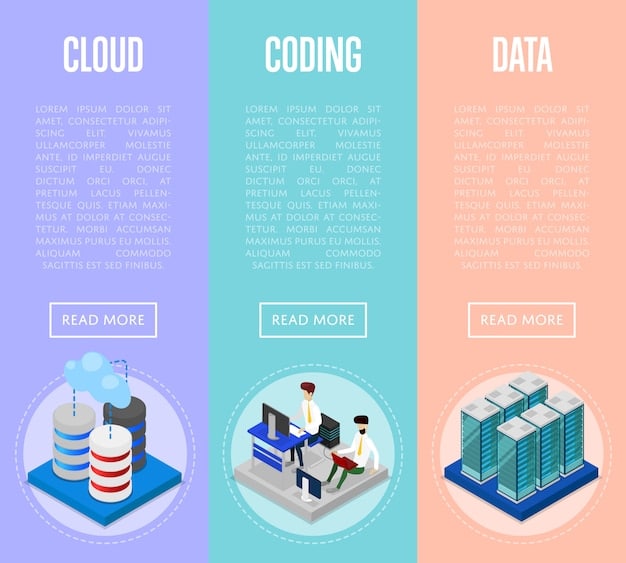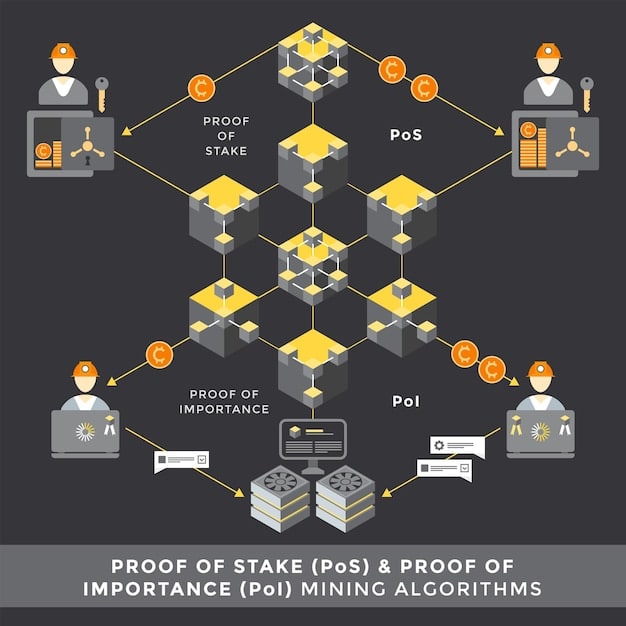How to Deploy Your AI Model to Production: A US Developer’s Guide

Deploying AI models to production using cloud services involves several steps, from choosing the right platform to monitoring performance, ensuring that US developers can effectively bring their AI innovations to market.
Ready to take your AI model from development to the real world? This guide provides a comprehensive overview of how to deploy your AI model to production using cloud services, tailored specifically for US developers.
Understanding the Landscape of AI Model Deployment
The journey from a trained AI model to a production-ready application involves navigating a complex landscape of tools, platforms, and strategies. Understanding this landscape is crucial for US developers aiming to deploy their AI models efficiently and effectively.
Before diving into the specifics, let’s explore the key considerations and challenges in deploying AI models to production environments.
Key Considerations for AI Model Deployment
Successful AI model deployment requires careful planning and attention to several critical factors. These considerations will help you make informed decisions and avoid common pitfalls.
- Scalability: Can your deployment infrastructure handle increasing user demand and data volumes?
- Latency: How quickly can your model respond to requests? Low latency is essential for real-time applications.
- Cost: What are the ongoing costs associated with hosting and maintaining your AI model?
- Monitoring: How will you track the performance and accuracy of your model in production?
Common Challenges in AI Model Deployment
Deploying AI models is not without its challenges. Being aware of these potential obstacles can help you prepare and mitigate risks.
- Infrastructure Complexity: Setting up and managing the necessary infrastructure can be daunting.
- Model Versioning: Keeping track of different model versions and ensuring compatibility can be complex.
- Data Drift: Changes in input data over time can degrade model performance.
- Security: Protecting your AI model and data from unauthorized access is crucial.
By addressing these considerations and challenges proactively, US developers can pave the way for successful AI model deployments.
Choosing the Right Cloud Service
Cloud services offer a powerful and flexible solution for deploying AI models to production. However, selecting the right cloud service is essential for meeting your specific needs and requirements.
Several leading cloud providers offer comprehensive AI deployment platforms. Let’s explore some of the most popular options.

Amazon Web Services (AWS)
AWS provides a range of services for AI model deployment, including SageMaker, ECS, and EKS. SageMaker offers a managed environment for training, deploying, and monitoring AI models.
AWS also provides tools for containerization (ECS and EKS) for deploying models as microservices.
Google Cloud Platform (GCP)
GCP offers AI Platform, Vertex AI, and Kubernetes Engine for AI model deployment. Vertex AI provides a unified platform for managing the entire AI lifecycle, from data preparation to model deployment.
GCP’s Kubernetes Engine allows you to deploy and scale your AI models using containers.
Microsoft Azure
Azure provides Azure Machine Learning, Azure Kubernetes Service (AKS), and Azure Container Instances (ACI) for AI model deployment. Azure Machine Learning offers a collaborative and scalable environment for building, deploying, and managing AI models.
AKS and ACI provide options for containerized deployment.
When choosing a cloud service, consider factors such as pricing, ease of use, scalability, and the availability of pre-built AI/ML tools. Each platform has its strengths and weaknesses, so carefully evaluate your options.
Preparing Your AI Model for Deployment
Before deploying your AI model, it’s crucial to prepare it for a production environment. This involves several steps, from model optimization to ensuring compatibility with the deployment platform.
Proper preparation can significantly improve the performance and reliability of your AI model in production.
Model Optimization Techniques
Optimizing your AI model can reduce its size, improve its speed, and lower its resource consumption. Here are some common optimization techniques:
- Quantization: Reducing the precision of model weights and activations can significantly reduce memory footprint and improve inference speed.
- Pruning: Removing less important connections from the model can reduce its size and improve its efficiency.
- Knowledge Distillation: Training a smaller, more efficient model to mimic the behavior of a larger, more accurate model.
Serialization and Deserialization
Serialization is the process of converting your AI model into a format that can be stored or transmitted. Deserialization is the reverse process, converting the serialized model back into its original form.
Common serialization formats include:
- Pickle: A Python-specific format for serializing Python objects.
- ONNX: An open standard for representing machine learning models.
- Protocol Buffers: A language-neutral, platform-neutral, extensible mechanism for serializing structured data.
Choose a serialization format that is compatible with your deployment platform and supports the necessary data types.
By optimizing and serializing your AI model, you can ensure that it is ready for deployment in a production environment.
Containerization with Docker
Containerization is a popular technique for packaging AI models and their dependencies into a single, portable unit. Docker is the most widely used containerization platform.
Using Docker can simplify deployment, improve consistency, and enhance scalability.
Creating a Dockerfile
A Dockerfile is a text file that contains instructions for building a Docker image. The Dockerfile specifies the base image, dependencies, and runtime environment for your AI model.
Here’s an example of a basic Dockerfile:
FROM python:3.8 WORKDIR /app COPY requirements.txt . RUN pip install -r requirements.txt COPY . . CMD ["python", "app.py"]
Building and Running a Docker Image
To build a Docker image from a Dockerfile, use the following command:
docker build -t my-ai-model .
To run the Docker image, use the following command:
docker run -p 8000:8000 my-ai-model
Docker Compose can be used to define and manage multi-container applications, making it easier to deploy complex AI models.
Benefits of Containerization
- Portability: Docker containers can run on any platform that supports Docker.
- Consistency: Docker ensures that your AI model runs in a consistent environment, regardless of the underlying infrastructure.
- Scalability: Docker makes it easy to scale your AI model by creating multiple containers.
Containerization with Docker is an essential skill for US developers deploying AI models to production.
Deploying to Kubernetes
Kubernetes is a powerful container orchestration platform that can automate the deployment, scaling, and management of containerized AI models. Deploying to Kubernetes can improve the efficiency and reliability of your AI applications.
Kubernetes provides a robust and scalable infrastructure for running AI models in production.

Creating a Kubernetes Deployment
A Kubernetes Deployment defines the desired state for your AI model, including the number of replicas, the container image, and the resource requirements.
Here’s an example of a Kubernetes Deployment configuration:
apiVersion: apps/v1
kind: Deployment
metadata:
name: my-ai-model-deployment
spec:
replicas: 3
selector:
matchLabels:
app: my-ai-model
template:
metadata:
labels:
app: my-ai-model
spec:
containers:
- name: my-ai-model-container
image: my-ai-model:latest
ports:
- containerPort: 8000
Creating a Kubernetes Service
A Kubernetes Service provides a stable endpoint for accessing your AI model. The Service abstracts the underlying pods and provides load balancing and service discovery.
Here’s an example of a Kubernetes Service configuration:
apiVersion: v1
kind: Service
metadata:
name: my-ai-model-service
spec:
selector:
app: my-ai-model
ports:
- protocol: TCP
port: 80
targetPort: 8000
type: LoadBalancer
Scaling and Monitoring
Kubernetes provides built-in features for scaling your AI model based on demand and monitoring its performance. You can use tools like Prometheus and Grafana to collect and visualize metrics.
By deploying to Kubernetes, US developers can leverage its powerful features to manage and scale their AI models efficiently.
Monitoring and Maintenance
Deploying an AI model is just the first step. Continuous monitoring and maintenance are essential for ensuring its long-term performance and reliability.
Monitoring and maintenance help you detect and address issues before they impact your users.
Performance Metrics
Tracking key performance metrics can help you identify potential problems and optimize your AI model. Some important metrics include:
- Latency: The time it takes for your model to respond to a request.
- Throughput: The number of requests your model can handle per unit of time.
- Accuracy: The percentage of correct predictions made by your model.
Data Drift Detection
Data drift occurs when the characteristics of the input data change over time, leading to a degradation in model performance. Monitoring for data drift can help you detect and mitigate this issue.
Techniques for detecting data drift include:
- Statistical Tests: Comparing the distributions of the input data over time.
- Drift Detection Algorithms: Using algorithms specifically designed to detect changes in data patterns.
Model Retraining
When data drift or other factors cause a significant drop in model performance, it may be necessary to retrain your AI model with new data. Automating the retraining process can help you keep your model up-to-date.
Regular monitoring and maintenance are crucial for ensuring the continued success of your AI model deployment.
| Key Point | Brief Description |
|---|---|
| 🚀 Choosing Cloud Service | Select AWS, GCP, or Azure based on needs. |
| 📦 Containerization with Docker | Use Docker to package models and dependencies. |
| ⚙️ Deploying to Kubernetes | Automate deployment with Kubernetes orchestration. |
| 📊 Monitoring & Maintenance | Track metrics and detect data drift for optimal performance. |
FAQ
▼
Amazon Web Services (AWS), Google Cloud Platform (GCP), and Microsoft Azure are leading options. Each provides unique tools and features tailored for AI model deployment, so choose based on your specific needs and budget.
▼
Containerization, using tools like Docker, packages the AI model and its dependencies into a single unit. This ensures consistency across different environments and simplifies deployment across various platforms.
▼
Monitor key performance metrics like latency, throughput, and accuracy. Use tools like Prometheus and Grafana to collect and visualize these metrics, helping you identify potential issues and optimize your model’s performance.
▼
Data drift occurs when the characteristics of input data change over time. To detect it, use statistical tests or drift detection algorithms to compare data distributions, enabling timely retraining and maintaining model accuracy.
▼
Kubernetes automates deploying, scaling, and managing containerized applications. It simplifies AI model orchestration, enhancing efficiency and reliability, making it ideal for complex and scalable AI deployments.
Conclusion
As a US developer, knowing how to deploy your AI model to production using cloud services is a crucial skill. By understanding the landscape, choosing the right cloud service, preparing your model, and employing containerization and orchestration techniques, you can successfully bring your AI innovations to market and monitor their performance to guarantee reliability and accuracy over time.





